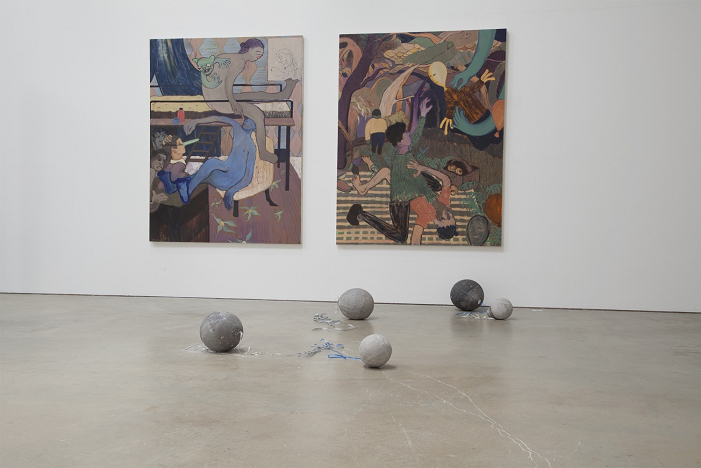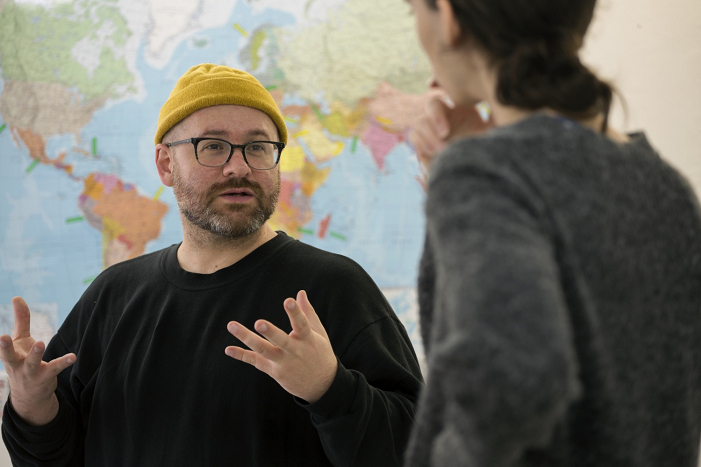In this section
BFA Programme Applying to Study for a BFA BFA FAQs Submitting a Portfolio BFA Affiliated Colleges Undergraduate Open Days 2026Downloads
BFA Handbook 2023-24 v.1.2 2024-25 Fine_Art_Admissions_Feedback_FINAL_(electronic version).pdf 2024-25 Fine_Art_Admissions_Feedback_FINAL_(print version).pdfBFA Programme
The BFA is a three-year, studio-based course in which students work alongside each other in collaboratively organised studios. It allows students to engage with the diversity of disciplines that shape contemporary art, including painting, sculpture, printmaking, photography, installation, video, sound, performance and other experimental forms.
75% of the course is dedicated to studio practice and 25% to the history & theory of visual culture. The two components of the course are closely integrated, and the historical and theoretical study of art is taught both in the lecture rooms and in the studios.
Students begin from the outset to develop their studio work in discussion with the School’s lecturers, tutors, and visiting staff, and each student is allocated a primary tutor with whom they meet regularly throughout the term. Students are initially encouraged to work across all media and then to develop their own focus and interests during the final two years of the course. Work is regularly presented and discussed at group crits involving staff and students from across the School.

Alongside the students’ individual studio work, workshops and projects designed to introduce a range of techniques and approaches are offered throughout the year. In addition, they attend taught human anatomy as well as lectures, seminars and tutorials in the history and theory of modern and contemporary visual culture. Students are encouraged to experiment in their studio practice and through debate and essay writing in the history and theory modules. Examinations take place at the end of the first year (prelims) and third year (finals); the second year provides the longest expanse of time for unfettered experimentation, underpinned by rigorous studio-practice, deep theoretical reflection and close tutorial support.
An unique aspect of the BFA is the teaching of human anatomy in the first year, which is supported by the Ruskin’s relationship with the University's Department of Physiology, Anatomy and Genetics. Through looking at the structure, form and function of the human body, this part of the course explores issues of identity, biology, dynamics and mortality while helping students to see below the surface of things and to find a visual language to express that knowledge. Anatomy also forms part of the preliminary examination.
In Michaelmas Term, there is a series of basic skills workshops, which are compulsory for first year students. These explore both core skills and specialist topics, ranging from medium-specific basics to sophisticated or unusual techniques. Recent workshops have focussed on video, sound and digital technology for artists, performance, as well as painting, print, 3D, photography and documentation. Throughout the year there are also invited Visiting Speakers who give a presentation about their work, research or practice and may offer with students specialist tutorials or workshops.

The Ruskin School is distinctive within the University insofar as all the teaching takes place within the department, rather than through the college-based tutorial system. However, each student is provided with a place in college and all tenured academic staff have a college association. The character of the Ruskin is shaped in part by the remarkable cohesion of its student body and the sense of shared endeavour that underpins the wide range of activities that are carried out in and through the School. The group of BFA candidates is intimate: no more than thirty students are admitted per year, and these small numbers facilitate the exchange of ideas amongst and across years, as well as making possible a staff to student ratio that is unbeatable among UK art schools. Various crossover activities are organised with graduate students and research fellows, and students also benefit from relationships formed across other disciplines within their colleges and throughout the University as a whole. Links to the professional art world in the UK and beyond are sustained through the School’s professional practice workshops, offsite exhibitions at other venues, close links with the University Museums and Modern Art Oxford, organised trips to galleries in London and elsewhere, and the series of talks by visiting speakers.


